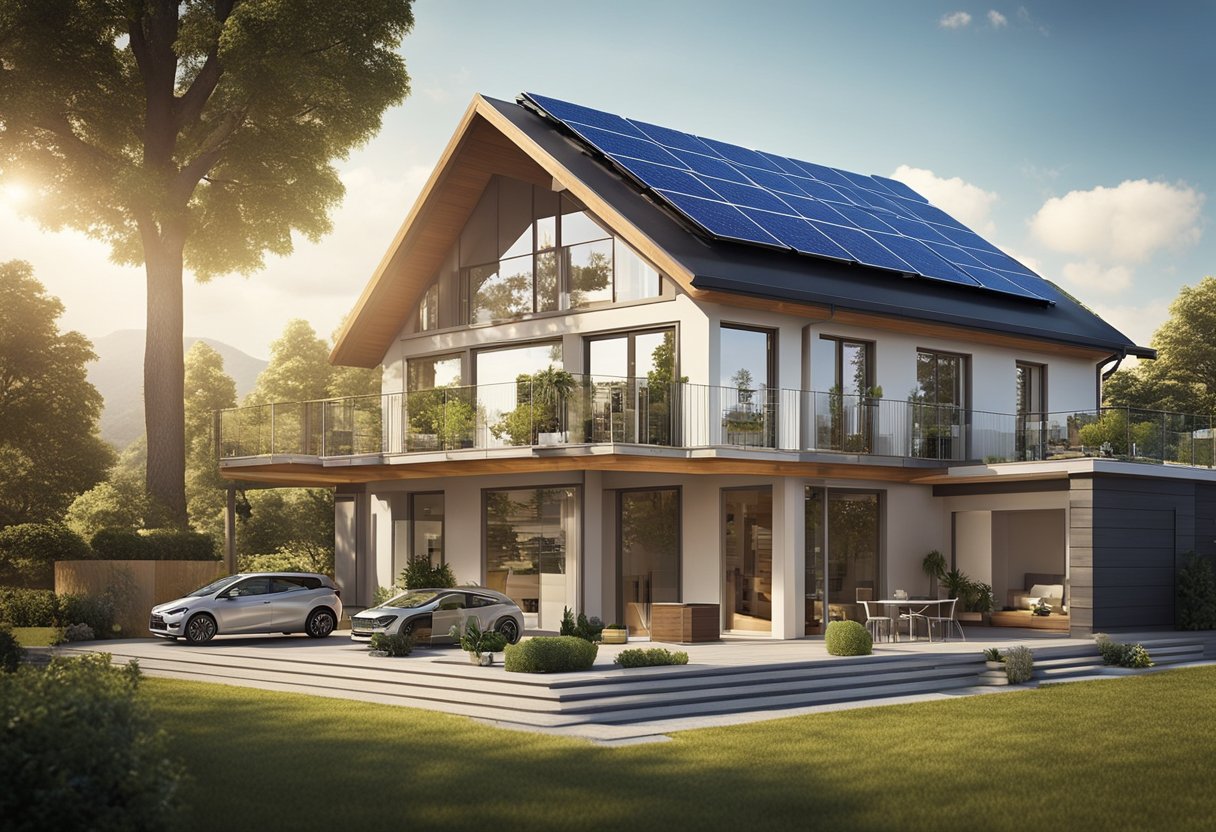Small Changes to Make Big Energy Savings at Home
The key to long term energy savings is to make small changes in the way we use and consume energy. We do not need to drastically overhaul our lives in order to save energy and money, but instead incorporate modest changes that we can be consistent with.
Making small changes around the home can lead to significant energy savings, benefiting both the household budget and the environment. With rising energy costs and growing environmental concerns, homeowners are increasingly looking for ways to reduce their energy consumption without compromising on comfort. Simple adjustments in daily habits and the mindful use of appliances can result in noticeable reductions in energy bills.

For instance, addressing the way one uses kitchen appliances or manages lighting can make a tangible difference. Energy-intensive appliances such as tumble dryers, electric showers, and kettles, when used more efficiently, can cut down on electricity usage. Similarly, taking measures to prevent heat loss, like sealing draughts, can improve a home’s energy efficiency. These practical steps not only contribute to cost savings but also help reduce a household’s carbon footprint.
Understanding and altering energy consumption patterns requires minimal effort but can achieve considerable benefits. It presents an opportunity for consumers to take control of their energy use, leading to a more sustainable lifestyle. Each small change, when adopted across numerous households, contributes collectively to a larger positive impact on energy conservation efforts.
Understanding Energy Use in the Home

Achieving energy savings begins with a clear understanding of one’s current energy consumption and the role appliances play in monthly energy bills. Focusing on specifics, this section breaks down the elements contributing to home energy usage.
Evaluating Current Energy Consumption
Households should first conduct an energy audit to establish a baseline of their energy consumption. This typically involves reviewing past energy bills to identify usage patterns and peak demand periods. Attention to details such as the energy consumed during different seasons provides insights into when and how energy is used, facilitating targeted strategies to save money and reduce the overall energy bill.
How Appliances Impact Energy Bills
Appliances contribute significantly to household energy bills. The energy usage of an appliance is contingent on its efficiency rating – more efficient appliances consume less energy for the same level of performance. Homeowners can assess the energy consumption of each appliance by examining its energy label or using an energy usage monitor. A table comparing the energy use of standard home appliances can provide clear insights into which devices are the costliest:
| Appliance | Average Energy Use |
|---|---|
| Fridge-Freezer | 200-400 kWh/year |
| Washing Machine | 150-500 kWh/year |
| Dishwasher | 200-300 kWh/year |
| Television | 100-300 kWh/year |
Upgrading to energy-efficient models and adopting conscientious usage behaviours can lead to discernible reductions in energy usage.
Heating and Insulation Techniques

Maximising energy efficiency in the home often hinges on two key strategies: effective temperature regulation and improving insulation. These approaches aim to retain heat, ensure energy is used judiciously, and reduce unnecessary loss.
Effective Use of Thermostats
One can achieve greater energy efficiency by installing and correctly using a thermostat to control their home’s heating system. Setting the thermostat to lower temperatures when the house is unoccupied, or during the night, can lead to significant energy savings. An optimal setting is typically around 18°C to 21°C during the day.
- Recommended Thermostat Settings:
- Daytime: 18°C – 21°C
- Nighttime: Lower by 1°C – 2°C from daytime or according to comfort.
Improving Home Insulation
Strategic house insulation is paramount in preventing heat escape. Insulating key areas such as lofts, roofs, walls, and around windows and doors can significantly retain warmth and cut energy costs. Roof and loft insulation can prevent approximately 30% of heat losses, and walls can account for a further 30% if not properly insulated.
- Key Insulation Areas:
- Attic/Loft: Use layers of insulating material.
- Cavity Walls: Consider cavity wall insulation.
- Solid Walls: Solid wall insulation can be internal or external.
- Windows/Doors: Double glazing or draught-proofing.
Smart Ways to Reduce Heat Loss
Efficient heating is not just about producing heat but also about reducing its loss. Ensuring there is ample space around radiators allows for better heat distribution. Also, draught-proofing doors and windows, sealing cracks, and using reflective panels behind radiators can prevent unnecessary heat loss.
- Techniques to Minimize Loss:
- Ensure radiators are not obstructed by furniture.
- Use draught excluders on external doors.
- Install reflective panels behind radiators to direct heat into the room.
By incorporating these targeted heating and insulation techniques, one can improve their home’s energy efficiency and achieve greater comfort while reducing their carbon footprint and energy bills.
Reducing Water-Related Energy Expenditure
Making small changes to water usage and heating can have a significant impact on energy savings. Efficient management of water in the home directly reduces energy consumption and, consequently, energy bills.
Hot Water Usage Optimisation
Showers: By opting for showers over baths and keeping them brief, individuals can significantly reduce hot water use. Installing an aerating showerhead can further decrease the amount of hot water and energy required.
Laundry: Utilising warm or cold water for laundry instead of hot can halve the energy used per load. It’s advantageous to wash clothes at temperatures of 20 degrees Celsius or lower whenever feasible.
Efficient Water Heating Solutions
Insulation: Properly insulating the hot water tank and associated pipework minimises heat loss, ensuring that less energy is required to maintain water temperature.
Upgrade: Replacing an old boiler with a more energy-efficient model can cut water heating costs. Condensing boilers, for instance, are more efficient as they capture and recycle heat that would otherwise be lost.
Smart Electricity Use and Appliances

Making considered choices in electrical appliances and their usage can lead to significant energy savings. By selecting energy-efficient appliances and employing techniques to reduce standby power waste, homeowners can reduce their electricity consumption.
Choosing Energy-Efficient Appliances
When in the market for new home appliances, one should prioritise energy efficiency. Labels such as the EU energy label provide a clear indication of an appliance’s energy consumption. Refrigerators, microwaves, and tumble dryers have varying degrees of efficiency, often represented by a rating from A+++ (most efficient) to G (least efficient).
- Fridges: An A+++ fridge can save up to 60% of energy compared to an A+ model.
- Microwave: Using a microwave for cooking instead of an oven can consume up to 80% less energy.
- Tumble Dryers: Heat pump dryers are more efficient than traditional condenser or vented dryers and can cut energy use significantly.
Techniques to Lower Standby Power Waste
Many appliances continue to consume electricity even when not actively in use, a phenomenon known as standby power waste. Employing energy monitors can help identify which appliances draw power unnecessarily.
- Energy Monitor: Utilising an energy monitor can inform one of high-consumption devices and times of peak usage.
- Appliances on Standby: Disconnecting appliances from power sources or switching off at the plug can prevent this waste. For example, turning off a TV completely instead of leaving it on standby can save up to 20% of the device’s energy consumption.
Optimising Daily Habits for Energy Saving

Making small changes to daily habits can significantly influence energy use and savings in the home. Focusing on kitchen practices and laundry routines, households can optimise energy consumption without compromising on convenience and efficiency.
Kitchen Efficiency: Cooking and Appliances
Cooking efficiently conserves energy and reduces bills. Utilising the microwave for heating small quantities of food is more energy-efficient than heating them in the oven. When using the oven, it’s practical to cook multiple dishes at once, leveraging the fact that the oven is already heated. Additionally, residents should consider investing in energy-efficient appliances like A-rated cookers that consume less power.
- Kettles should be filled with only as much water as needed, as boiling excess water wastes energy.
- Choose an energy-efficient kettle that consumes less power per boil.
Utilising smaller appliances such as a toaster oven or an electric pressure cooker for smaller meals instead of the oven can also make a significant difference.
Laundry: Maximising Energy Efficiency
Washing machines represent a substantial portion of a household’s energy consumption. To save energy:
- Run full loads to maximise the efficiency of each wash cycle.
- Wash at lower temperatures; modern detergents are effective even at 30°C.
- Employ the economy setting if available, which is designed to save energy and water.
Tumble dryers are high-energy appliances; thus, air drying clothes when possible is favourable. For those occasions when a dryer is necessary, one should:
- Dry full loads to reduce the number of cycles.
- Clean the lint filter before each cycle to maintain efficiency.
By making informed choices and small alterations to daily routines, individuals can make a sizeable impact on their energy costs.
Intelligent Lighting and Gadgets

Intelligent lighting and gadgets have become crucial in reducing household energy consumption. Through modern lighting solutions and efficient management of electronics, significant energy savings can be achieved.
Switching to LED and Smart Lighting
LED Light Bulbs: In comparison to traditional incandescent bulbs, LED bulbs are vastly more energy-efficient, using up to 90% less energy and lasting up to 25 times longer. Swapping out old bulbs for LEDs is a simple yet effective step towards reducing energy bills.
Smart Lighting Systems: These systems allow users to control lighting remotely via smartphone apps or voice commands, enabling them to dim lights or schedule their operation, which further conserves energy. Smart bulbs can also adjust lighting based on natural light levels, presence in the room, or even time of day, enhancing energy savings.
Managing Gadgets and Electronics for Lower Energy Use
Television Sets: TVs should be set to energy-saving modes, which optimize screen brightness and reduce power consumption. More modern TVs generally come with this feature and are designed to be more energy-efficient.
Gadgets and Electronics: On standby mode, devices like radios, gaming consoles, and chargers still consume energy. It is advisable to:
- Pull the plug on devices not in use to avoid ‘vampire’ energy drain.
- Use smart plugs to control power to gadgets remotely, allowing one to turn off devices even when away from home.
- Invest in energy monitors to track and manage the energy usage of these devices effectively.
By paying attention to the details of how lighting and gadgets are used around the home, households can enjoy both enhanced functionality and energy savings.
Renewable Energy and Long-Term Savings

Investing in renewable energy solutions such as solar installations and battery storage systems can result in significant cost savings over time and contribute to environmental sustainability.
The Benefits of Solar Energy Installations
Solar energy installations are a cornerstone of renewable energy options for homeowners looking to save money and reduce their reliance on traditional fuels. Installing solar panels on a home not only decreases electricity bills but also adds to the property’s value. Solar panels capture energy from the sun and transform it into usable electricity, reducing the need for power from the grid. Additionally, solar thermal panels provide an eco-friendly way to heat water, further diminishing energy consumption.
Battery Storage Systems to Maximise Renewable Usage
To enhance the effectiveness of solar energy systems, homeowners can incorporate battery storage solutions. These systems store excess energy produced during peak sunlight hours. They allow for the utilisation of stored solar power during periods of low sunlight or at night, ensuring a consistent supply of renewable energy and maximising savings on energy bills. Moreover, by decreasing the demand on the grid during high-use times, battery storage systems can help reduce overall strain on power infrastructures.
Working with Suppliers and Using External Resources
In efforts to reduce energy consumption and costs, homeowners should consider their relationship with energy suppliers and the utilisation of available government resources. Strategic choices in these areas can lead to significant savings.
Choosing the Right Energy Tariff
Selecting an appropriate energy tariff from a supplier is fundamental to managing home energy costs effectively. Homeowners should regularly assess their energy bills and consumption patterns, making use of smart meters to track usage in real-time. They are encouraged to consult with their suppliers about the most cost-efficient plans tailored to their lifestyle. This could involve a fixed tariff for predictable billing or a variable tariff that capitalises on lower off-peak rates.
- Fixed Tariffs: Locks in a price for each unit of energy for a set period
- Variable Tariffs: Price per unit can fluctuate with the wholesale energy market
Analyse the Energy Efficiency Rating of the home to ensure that the chosen tariff complements the energy profile of the property effectively.
Utilising Government and Regulatory Information and Schemes
Government resources and regulatory bodies such as Ofgem provide indispensable information and schemes that encourage energy efficiency. Homeowners in the UK can access detailed guidance from governmental websites, which cover a range of grants and incentives designed to make homes more energy-efficient.
Homeowners may be eligible for grants such as those listed on gov.uk for insulation and heating system upgrades. These not only make homes more comfortable but can also lead to reduced energy bills.
- Insulation Grants: Potentially cover a portion of the cost of home insulation
- Heating System Upgrades: Financial support for more efficient boilers and renewable heating systems
Homeowners should investigate and apply for available schemes, ensuring they meet any necessary criteria for eligibility. Regular engagement with Ofgem and supplier news will keep them informed of any new opportunities as they arise.
BER Assessors Dublin
As one of the most established home insulation companies in Dublin, Usher Insulations are experts in how to save energy and money. We perform BER Assessments to highlight exactly where your home is wasting energy and create a plan to rectify the issues. We have conducted hundreds of building energy assessment tests and have helped clients identify and correct areas where they were wasting energy and wasting money. For further advice and to hear about our range of energy saving products speak to a member of our team on 018201921.